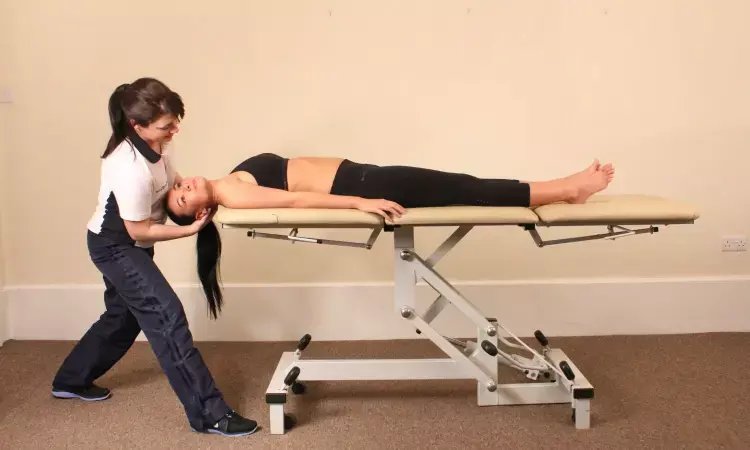- Home
- Medical news & Guidelines
- Anesthesiology
- Cardiology and CTVS
- Critical Care
- Dentistry
- Dermatology
- Diabetes and Endocrinology
- ENT
- Gastroenterology
- Medicine
- Nephrology
- Neurology
- Obstretics-Gynaecology
- Oncology
- Ophthalmology
- Orthopaedics
- Pediatrics-Neonatology
- Psychiatry
- Pulmonology
- Radiology
- Surgery
- Urology
- Laboratory Medicine
- Diet
- Nursing
- Paramedical
- Physiotherapy
- Health news
- Fact Check
- Bone Health Fact Check
- Brain Health Fact Check
- Cancer Related Fact Check
- Child Care Fact Check
- Dental and oral health fact check
- Diabetes and metabolic health fact check
- Diet and Nutrition Fact Check
- Eye and ENT Care Fact Check
- Fitness fact check
- Gut health fact check
- Heart health fact check
- Kidney health fact check
- Medical education fact check
- Men's health fact check
- Respiratory fact check
- Skin and hair care fact check
- Vaccine and Immunization fact check
- Women's health fact check
- AYUSH
- State News
- Andaman and Nicobar Islands
- Andhra Pradesh
- Arunachal Pradesh
- Assam
- Bihar
- Chandigarh
- Chattisgarh
- Dadra and Nagar Haveli
- Daman and Diu
- Delhi
- Goa
- Gujarat
- Haryana
- Himachal Pradesh
- Jammu & Kashmir
- Jharkhand
- Karnataka
- Kerala
- Ladakh
- Lakshadweep
- Madhya Pradesh
- Maharashtra
- Manipur
- Meghalaya
- Mizoram
- Nagaland
- Odisha
- Puducherry
- Punjab
- Rajasthan
- Sikkim
- Tamil Nadu
- Telangana
- Tripura
- Uttar Pradesh
- Uttrakhand
- West Bengal
- Medical Education
- Industry
Modified Epley maneuver bests traditional approach for treating PC-benign paroxysmal positional vertigo

China: A recent study has revealed the modified Epley maneuver is more effective than the traditional Epley maneuver in improving the single repositioning success rate and reducing the canal switching rate for posterior semicircular canal benign paroxysmal positional vertigo (PC-BPPV).
A modified Epley maneuver for posterior semicircular canal BPPV treatment, involving extended time in the healthy side-lying position and final bowing, achieved an impressive 85% success rate after the first attempt, compared to the traditional Epley maneuvre's success rate of 63%," the researchers reported in Frontiers in Neurology.
" After two attempts, the experimental group reached 100% repositioning success, while the control group required three attempts for an 86% success rate."
Benign paroxysmal positional vertigo is a prevalent cause of vertigo, accounting for 17–42% of reported cases. Manifesting as brief episodes of nystagmus and vertigo, BPPV is triggered by alterations in head position relative to gravity, such as turning over, lying down, or standing up. BPPV is further divided based on the involved semicircular canal, with posterior canal BPPV (PC-BPPV) being the most prevalent, accounting for 80% of cases.
Xiaosu Chen, Wenzhou Third Clinical Institute Affiliated to Wenzhou Medical University, Wenzhou People’s Hospital, Wenzhou, China, and colleagues compared the repositioning effect of the modified Epley maneuver and the traditional Epley maneuver for posterior semicircular canal benign paroxysmal positional vertigo.
The study included sixty-five patients with unilateral PC-BPPV. They were randomly divided into two groups: the experimental group received the modified Epley maneuver, which prolonged the time in the healthy side-lying position and the final bowing position and the control group received the traditional Epley maneuver.
The researchers recorded and compared the number of successful repositions after one, two, and three attempts and the total number of successful repositions between the two groups. A BPPV virtual simulation model was used to analyze the mechanism of the modified Epley maneuver.
The study revealed the following findings:
- The first repositioning success rate of the experimental group was significantly higher than that of the control group (85% versus 63%).
- The experimental group achieved a 100% repositioning success rate after two attempts, while the control group needed three attempts to reach an 86% repositioning success rate.
- Four cases in the control group experienced canal switching during the repositioning process, while none in the experimental group did.
- The BPPV virtual simulation model showed that the modified Epley maneuver could facilitate the passage of otoliths through the posterior arm of the posterior semicircular canal, especially through the location of the obstruction.
"Our study contributes a novel treatment approach for posterior canal BPPV patients, particularly those with refractory cases, offering a promising therapeutic option," the researchers concluded.
Reference:
Chen, X., Mao, J., Ye, H., Fan, L., Tong, Q., Zhang, H., Wu, C., & Yang, X. (2023). The effectiveness of the modified Epley maneuver for the treatment of posterior semicircular canal benign paroxysmal positional vertigo. Frontiers in Neurology, 14, 1328896. https://doi.org/10.3389/fneur.2023.1328896
Dr Kamal Kant Kohli-MBBS, DTCD- a chest specialist with more than 30 years of practice and a flair for writing clinical articles, Dr Kamal Kant Kohli joined Medical Dialogues as a Chief Editor of Medical News. Besides writing articles, as an editor, he proofreads and verifies all the medical content published on Medical Dialogues including those coming from journals, studies,medical conferences,guidelines etc. Email: drkohli@medicaldialogues.in. Contact no. 011-43720751


